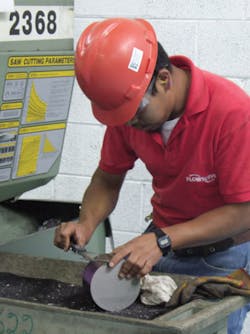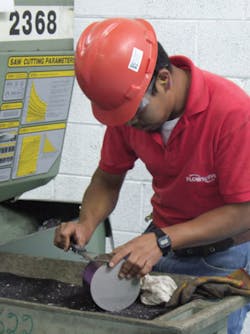Flowserve's dual strategy hits branding bull's-eye
Over several decades, Flowserve had acquired a portfolio of dominant fluid motion and control businesses around the world. And these businesses carried with them industrial brands with solid market share in a wide variety of vertical industries and regional sectors. How did Flowserve manage this complex branding scenario?
David Abels
Start with more than 50 heritage brands. Add a long line of highly engineered products with life cycles of up to 50 years.
Now, picture hundreds of offices, thousands of employees, and sales channels in more than 50 countries. For final measure, throw it all under the umbrella of a newly formed company that combines vast business experience and expertise with industry-leading brand names dating back as far as the 1800s. How do you manage that complex matrix, respect its heritage and, at the same time, compete in a fast-moving global marketplace?
This branding scenario was the marketing challenge for Dallas-based Flowserve Corp., a Fortune 1000 company and leading provider of valves, pumps, seals and steam solutions. Flowserve’s customers include the world’s infrastructure business and process industries including the oil and gas, power, water and chemical markets.
According to industrial analyst Craig Resnick, a director of research at the ARC Advisory Group, brand awareness and brand longevity are key in the industrial marketplace. For companies like Flowserve, whose products have decades-long life cycles, maintaining the value in a brand or product name is essential for gaining repeat sales and more lucrative asset-management contracts, and for retaining the loyalty of longtime customers. If a customer is comfortable ordering your legacy brand, why rock the boat? If it’s easy for a purchasing manager to spec your product by the name he knows on an RFP — a name he associates with reliability, proven quality and trusted support — why change now? These questions loomed large for Flowserve.
Battle for market share
Moving quickly to a single global brand raised concerns for Flowserve management. Market studies seemed to lend credence to the concept of leaving successful heritage brands alone. A 2002 survey, “Brand Strategy in the Industrial Market,” from Frank Lynn & Associates, found that in 14 of 18 industrial manufacturing categories the top brand commanded more than 50 percent market share.
“We’ve found that many corporations have gone to a dual branding strategy with a strong corporate brand and sub-brands to hold on to those sub-brand values,” says Bob Segal, principal, Frank Lynn & Associates. “The corporate brand is used for large audiences like investors and large clients, and the sub-brands are used for more refined audiences, like specific market customers.
After extensive market research and customer surveys, a clearer picture emerged — a dual branding strategy was needed that would both meet Flowserve’s global growth objectives and exploit the value of its flagship brands. An analysis of the vast majority of Flowserve’s legacy brands showed that customers placed value on heritage company names associated with products they purchased. For example, Gestra was synonymous with steam solutions. Borg Warner equaled fail-safe sealing solutions. Durco meant reliability in pumps. Limitorque stood for the highest quality in valve automation, Edward for premium gate globe and check valves.
The Flowserve management team decided on a dual branding strategy that enables Flowserve to cost-effectively market the parent brand to gain penetration into mature and emerging markets. According to John Jacko, Flowserve’s vice president and chief marketing officer, “A lot of industrial groups have taken profitable product branding and made it overly complex by branding products on a whim. We have focused our marketing efforts and resources on developing a credible, consistent, well-designed and well-supported Flowserve parent brand that mirrors our customers’ needs to simplify their supplier base, increase their efficiencies and lower their costs.
“We believe we are hitting the industrial branding bull’s-eye by streamlining our offerings. We understood that to be effective, we needed to distinguish Flowserve as a ‘branded house’ rather than a ‘house of brands’.”
To get employees engaged in building a Flowserve brand, Flowserve devised a new mission, vision, brand promise, and tag line — messaging and addressing them throughout their intranet, internal company publications, and other media.
A simultaneous external branding effort was undertaken to streamline and coordinate marketing efforts through the company’s network of advertising agencies around the world. Jacko and the integrated marketing communications team kicked off a global branding initiative with the development of a strong, easy-to-implement graphic identity program that was launched in Italy in 2004.
Flowserve’s primary goal is to be the most recognized and preferred supplier of fluid motion and control products and services in the world. Successfully integrating more than 50 heritage brands — and their inherent brand equities — has become key to reaching that goal. The branding strategy has enabled the company to rapidly position itself to its internal and external audiences, meet global demands and streamline new market penetration efforts with a portfolio of products and services under the global Flowserve umbrella.
Author’s Note
David Abels is the senior account executive of Koroberi, Inc, based in Chapel Hill, North Carolina, USA. For more information, contact the author by email: [email protected].
Caution turns to advocacy
Flowserve’s dual branding strategy of Gestra AG, a 100-years-old number one brand in Germany, succeeds after a transition of two and one-half years.
Tradition, loyalty and craftsmanship are important facets of the relationship that many European employees have with their employers. These strong ties build significant value into some of the oldest and most well known brands in the continent’s industrial sector.
Flowserve acquired one of these brands in 2002 when it bought the companies of the Flow Control division of a UK holding company, Invensys plc. Included in the acquisition was Germany’s Gestra AG, a 100-year-old internationally known leader in steam management systems. Gestra was a dominant number-one brand in Germany, and a close number two throughout Europe.
At first some Gestra management and employees were cautious of the merger. The company had avoided a total rebranding when Invensys had acquired it, and there was concern that with the Flowserve acquisition might come globalization of a company with a strong pan-European identity. What’s more, the purchase by a large American company accentuated the need to bridge communication techniques, corporate cultures and business customs.
Initially, Flowserve management wanted the 400- employee Gestra to transition immediately to a Flowserve company, Lutz Oelsner, president of Flowserve Gestra, said “We didn’t question the corporate decision to migrate Gestra to a Flowserve brand, but we thought our customers and employees would need more time.”
Oelsner’s opinion was borne out by the market. Early feedback had some customers turning away salesmen, saying that they did not know what Flowserve was, had never dealt with the company before, and would not deal with them now.
Gestra representatives and Flowserve management agreed to a two-and-a-half-year transition that would give Gestra the time it wanted. Gestra would employ Flowserve’s dual branding strategy to brand Gestra as a Flowserve sub-brand, renaming the company Flowserve Gestra. One of the first actions by Gestra was to call an all-employee meeting at which Oelsner laid out the timetable and identity milestones for the rebranding process. “That communication coming from the top was very, very important,” said John Jacko, Flowserve vice president and chief marketing officer.
A series of communications was launched including a letter to 5,600 Gestra customers. The letter spelled out the benefits of becoming a client of Flowserve, and underscored how the great quality and service that made Gestra a leading brand would be preserved. Gestra marketing management also used regular customer symposiums to get customers acquainted with the transition.
During the transition, Flowserve Gestra changed its logo, website, packaging, tradeshow materials and product identification. “For our distributors and customers, the packaging change was a dramatic indicator that the brand had really changed,” said Andreas Lubisch, Flowserve Gestra marketing director. “All of a sudden, where there were blue Gestra boxes before, the warehouses were lined with solid red. Not only did it affect our distributors, it sent a positive visual message to our manufacturing team.”
Now, Flowserve Gestra employees are clearly leading advocates of the adoption of the corporate branding. Cultural, language and globalization concerns have been replaced with loyalty to everything Flowserve.



